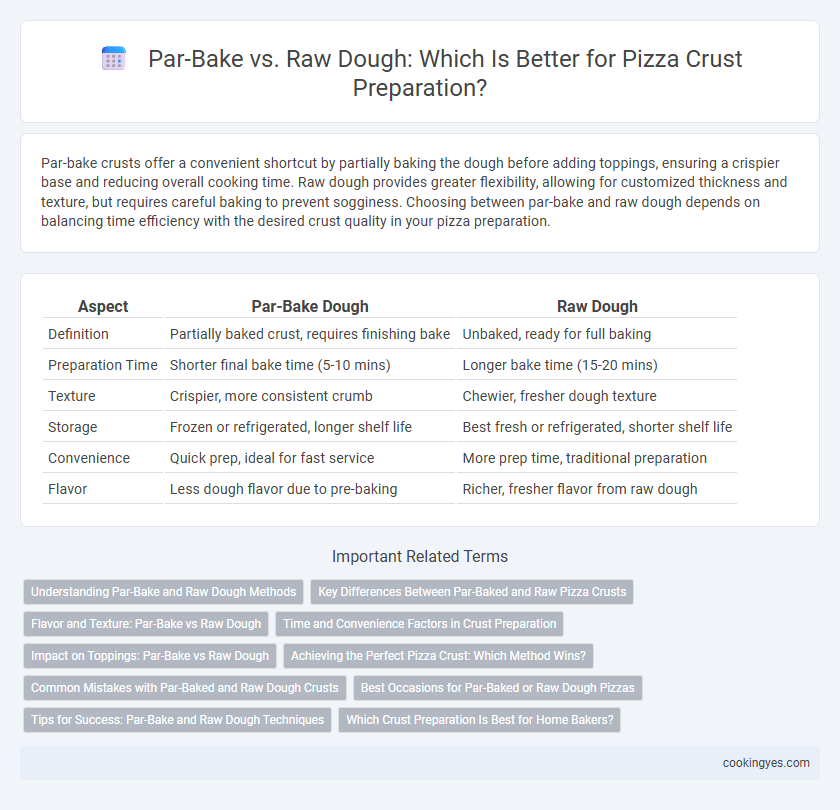Par-bake crusts offer a convenient shortcut by partially baking the dough before adding toppings, ensuring a crispier base and reducing overall cooking time. Raw dough provides greater flexibility, allowing for customized thickness and texture, but requires careful baking to prevent sogginess. Choosing between par-bake and raw dough depends on balancing time efficiency with the desired crust quality in your pizza preparation.
Table of Comparison
| Aspect | Par-Bake Dough | Raw Dough |
|---|---|---|
| Definition | Partially baked crust, requires finishing bake | Unbaked, ready for full baking |
| Preparation Time | Shorter final bake time (5-10 mins) | Longer bake time (15-20 mins) |
| Texture | Crispier, more consistent crumb | Chewier, fresher dough texture |
| Storage | Frozen or refrigerated, longer shelf life | Best fresh or refrigerated, shorter shelf life |
| Convenience | Quick prep, ideal for fast service | More prep time, traditional preparation |
| Flavor | Less dough flavor due to pre-baking | Richer, fresher flavor from raw dough |
Understanding Par-Bake and Raw Dough Methods
Par-bake involves partially baking the pizza crust before adding toppings, which creates a firmer base that resists sogginess and shortens final baking time. Raw dough, on the other hand, is baked with toppings from start to finish, allowing the crust to develop a chewier texture and deeper flavor through full baking. Understanding these methods helps choose the right crust preparation for desired texture, moisture control, and kitchen workflow efficiency.
Key Differences Between Par-Baked and Raw Pizza Crusts
Par-baked pizza crusts undergo partial baking before freezing, allowing for a quicker final bake and a consistently crispy texture. Raw pizza dough requires a full baking cycle, offering greater control over crust thickness and chewiness but demanding longer preparation time. The choice between par-baked and raw dough impacts kitchen efficiency, crust quality, and final pizza taste.
Flavor and Texture: Par-Bake vs Raw Dough
Par-baking pizza crust enhances texture by creating a crispy exterior while maintaining a chewy interior, offering a more consistent bake and preventing sogginess from toppings. Raw dough allows for a fresher, yeastier flavor profile and a softer, airier crust but may result in uneven cooking or a less crispy base. Choosing between par-baked and raw dough depends on balancing desired flavor intensity and textural contrast in the final pizza.
Time and Convenience Factors in Crust Preparation
Par-bake pizza crust reduces overall cooking time by partially baking the dough, allowing for faster final preparation and a crispier texture. Using raw dough requires longer baking, increasing preparation time but offering more control over crust thickness and texture. Par-baked crusts provide convenience for quick meals, while raw dough suits those prioritizing customization despite longer prep times.
Impact on Toppings: Par-Bake vs Raw Dough
Par-baking pizza crust partially cooks the dough, creating a firmer surface that prevents toppings from soaking in and ensures a crisper, more stable base during baking. Raw dough absorbs moisture from toppings, potentially leading to a soggy crust if not baked correctly, which can affect texture and flavor balance. Choosing par-baked crust enhances moisture control and topping integrity, resulting in a consistently crispier pizza experience.
Achieving the Perfect Pizza Crust: Which Method Wins?
Par-baked pizza crust offers a crisp texture and reduced baking time, making it ideal for consistent results in busy kitchens, while raw dough allows for greater customization in thickness and flavor development during the final bake. Achieving the perfect pizza crust depends on balancing convenience and control; par-baking provides efficiency and uniformity, whereas raw dough delivers fresh, artisanal qualities. Selecting between par-bake and raw dough ultimately hinges on desired crust texture, preparation time, and production scale.
Common Mistakes with Par-Baked and Raw Dough Crusts
Common mistakes with par-baked pizza crust include overbaking, which leads to a dry, brittle texture, and underbaking, resulting in a soggy middle. Using raw dough, errors often involve improper fermentation causing dense crusts and insufficient pre-baking temperatures that prevent crispiness. Consistently monitoring oven temperature and baking time ensures optimal crust quality for both par-baked and raw dough methods.
Best Occasions for Par-Baked or Raw Dough Pizzas
Par-baked pizza crusts are ideal for busy restaurants or events requiring quick preparation without compromising texture, offering a crisp base ready for immediate topping and baking. Raw dough suits artisanal pizzerias and home cooks who prioritize flavor development and custom dough fermentation, allowing full control over crust thickness and bake quality. For catering or takeaway, par-baked crusts enhance efficiency, while raw dough excels in settings favoring freshness and traditional pizza craft.
Tips for Success: Par-Bake and Raw Dough Techniques
Par-baking pizza crust involves partially baking the dough before adding toppings, which prevents sogginess and ensures a crisp, sturdy base; maintain oven temperature around 450degF (232degC) for 5-7 minutes to achieve optimal results. When using raw dough, stretch it thin and create a dimpled surface with your fingertips to allow heat circulation and avoid air bubbles, then bake at a high temperature of 475-500degF (246-260degC) for 10-12 minutes. For best results, use a pizza stone or steel to evenly distribute heat, regardless of par-baking or raw dough, to produce a perfectly cooked crust with ideal texture.
Which Crust Preparation Is Best for Home Bakers?
Par-bake crust offers home bakers convenience with a partially cooked base that reduces overall baking time and ensures a crisp texture, ideal for quick meal preparation. Raw dough allows for greater customization in thickness and flavor development through fermentation, delivering a fresher, artisanal quality favored by pizza enthusiasts. Choosing between par-bake and raw dough depends on balancing time-saving convenience with the desire for authentic texture and personalized taste in homemade pizza.
Par-bake vs Raw dough for crust preparation Infographic

 cookingyes.com
cookingyes.com